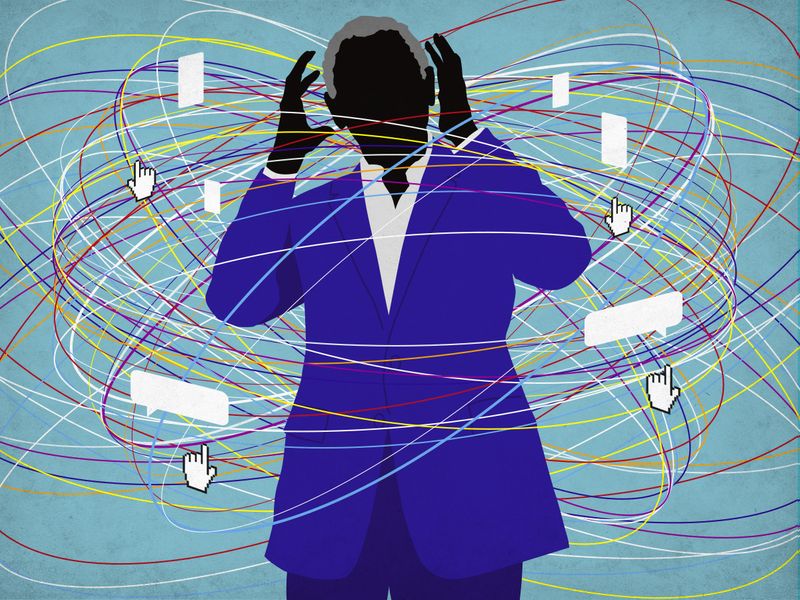
Derek Pando rarely had problems with his home internet service — until last week. That was when he began working from his house because of the coronavirus.
Pando, 35, a tech worker in Palo Alto, California, immediately started using work applications like video conferencing that ate up a lot of data. And he shared his internet service — which was built atop a premium broadband internet package from Comcast and a state-of-the-art home WiFi network — with his wife, who was also working at home, and their two children, who at times streamed movies.
After five days of this activity, his internet ground to a halt, Pando said. Google Docs froze, and he couldn’t get on video calls or send big email attachments.
“It’s never gotten that bad,” he said.
As millions of people across the United States shift to working and learning from home this week to limit the spread of the coronavirus, they test internet networks with one of the biggest mass behaviour changes that the nation has experienced.
That is set to strain the internet’s underlying infrastructure, with the burden likely to be particularly felt in two areas: The home networks that people have set up in their residences, and the home internet services from Comcast, Charter and Verizon that those home networks rely on.

That infrastructure is generally accustomed to certain peaks of activity at specific times of the day, such as in the evening when people return from work and get online at home. But the massive transfer of work and learning to people’s homes will show new heights of internet use, with many users sharing the same internet connections throughout the day and using data-hungry apps that are usually reserved for offices and schools.
That may challenge what are known as last-mile services, which are the cable broadband and fibre-based broadband services that pipe the internet into homes. These tend to provide a very different internet service than in offices and schools, which typically have “enterprise grade” internet broadband service. In broad terms, many offices and schools essentially have the equivalent of a big pipe to carry internet traffic, compared to a smaller garden hose for most homes.
On top of that, home networks — such as the WiFi routers that people set up in their residences — can be finicky. Many consumers have broadband plans with much lower capacity than in the workplace. And when many people are loaded onto a single WiFi network at the same time to stream movies or to do video conferencing, that can cause congestion and slowness.
“We just don’t know” how the infrastructure will fare, said Tom Wheeler, a former chairman of the Federal Communications Commission. “What is sufficient bandwidth for a couple of home computers for a husband and wife may not be sufficient when you add students who are going to class all day long operating from home.”
Usage of bandwidth-hogging apps and games has already shot up in places where the coronavirus has taken hold. In Italy, housebound children playing video games like Fortnite pushed internet traffic over one local landline network, Telecom Italia SpA, up more than 70 per cent late last month and early this month. And in parts of Europe last week, traffic to WebEx, a videoconferencing service run by Cisco, soared as much as 70 per cent to 80 per cent, the company said.
In Seattle, which has been a centre of the virus outbreak in the US, internet traffic started spiking on January 30, nine days after the first positive case of the virus in the area with people accessing news and using chat apps, according to security company Cloudflare. Last week, overall internet traffic in Seattle rose 30 per cent compared with a normal week for the city in January.

Cogent Communications and Zayo, which provide internet services to big companies and municipalities, said they have also seen recent spikes in traffic from banks, retailers and technology companies in the US to their remote employees.
In response, Verizon, Charter, Cox, Comcast and AT&T said they were confident they could meet the demands placed on their home internet services, which includes cable broadband like Xfinity, fibre-based broadband like FIOS, mobile LTE services from Verizon and AT&T and WiFi hot spots. And they added that they were taking measures to help people who are working and learning from home.
Cox said last week that it would automatically upgrade users of its basic broadband internet package, with speeds of 30 megabits per second, to a package with 50 megabits per second. That could help people deal with a rise in internet use and apps that require faster speeds and more bandwidth.
Comcast said that for the next two months, it would lift data caps that limit broadband use so that people who surpass the limits of their data plans won’t be penalised.
AT&T, Verizon and Charter said they were also preparing to increase capacity on their networks if needed, with more equipment to upgrade networks and emergency roll-in cell towers that are used to keep people online during natural disasters.
“Verizon operates its networks every day as though it’s a snow day,” said Kyle Malady, Verizon’s chief technology officer. “Delivering reliable networks is what we do.”
On Friday, Ajit Pai, the FCC chairman, also introduced the Keep Americans Connected Pledge, whose dozens of signatories include Altice USA, CenturyLink and Sprint. They committed to not penalize Americans with termination of internet service or by levying fees if people delayed their internet service payments, at least for the next two months.
Jon Peha, a professor of electrical engineering at Carnegie Mellon University and a former chief technology officer of the FCC, said he was grappling with how to conduct online lectures from his Pittsburgh home because the campus has shut down in the face of the virus.
Because Peha was nervous about his cable broadband provider’s ability to handle the intensity of services like video conferencing, which requires constant back-and-forth transfers of data packets with no interruptions from broadband congestion, he said he was considering upgrading his internet service.
He said the entirety of the internet infrastructure — home networks, last-mile services, private networks run by companies, the points of interchange between networks and the backbone superhighway at the core — will be stress-tested in coming days.
“Lives depend on reducing face-to-face interaction, and the internet is perfect for that,” Peha said. “But there is a risk that usage will surge and capacity will be inadequate and performance will suffer. This is new ground for all of us.”
As for Pando, he tried various ways to get his internet service to speed up.
First, he turned off other devices in the home that were connected to his WiFi network and made sure his wife and children weren’t online at the same time. Then he took a 75-foot Ethernet cable, which could feed his home broadband service directly into a device, and wrapped it around the home from the living room router to plug directly into his laptop.
It helped — but only a little.
Last Friday, Pando got an email from Comcast saying it would soon increase bandwidth to help meet the greater demands from customers who were working from home.
“It’s good to know they’re worried too,” he said.
Remote working brings new challenges to the internet
Coronavirus is testing out just how reliable tech infrastructure is

By Sami Zaatari, Staff Reporter and Sarah Diaa, Staff Reporter
Dubai: As schools and colleges around the UAE are shut and more and more employees in the country take to a work-from-home schedule to counter the growing coronavirus threat around the world, it has obviously taken a toll on internet connectivity and speed — particularly home internet.
Etisalat, one of the two telecom providers in the UAE, said it is actively assessing its network to manage the expected increase in bandwidth and mobile network demand. The company said it expects overall data traffic on its network to “surge exponentially” as more people self-isolate and work from home.
“Etisalat recently increased its local network capacity while also boosting its international data capacity to [provide] all customers with the best possible experience ...” a statement said.
Meanwhile, du said it will be doubling the internet speed at no additional cost for schools and universities across the country to ensure students will have a smooth experience with online classes.
In terms of infrastructure, a sales executive from Atlas Telecom, a group that specialises in communications technology, said the UAE’s networks are prepared to handle the surge in demand.
“There is obviously a slim chance that there could be issues because a lot of people are going to be working from home using many different programmes and applications, so there’s going to be a lot of bandwidth usage. But it all depends on how much bandwidth we’re talking about,” the executive told Gulf News, pointing that the UAE’s investments over the years in building up its networks will come in handy.
Despite that, challenges persist
The Dubai Financial Services Authority (DFSA) warned on Tuesday that the current circumstances can increase the vulnerability of financial institutions to cyberattacks, phishing attempts and fraud. The authority called on companies in Dubai’s International Financial Centre to use its Cyber Threat Intelligence Platform to enhance their cybersecurity.
And it’s not just in the UAE where there are concerns about cybersecurity. Data from Atlas VPN shows that the usage of VPNs across the world has surged since an ever-increasing number of people started going into quarantine due to the coronavirus outbreak.
According to latest data, in the past two weeks alone, VPN usage jumped by 124 per cent in the United States and 160 per cent in Italy. The increase comes as more companies use VPNs to protect proprietary information while their employees work remotely and from different devices.
Atlas VPN said in a report that not only did the number of people using a VPN increase, but the frequency and the time of connection increased as well. It pointed out that as new cities report cases of coronavirus infections, VPN usage in these locations increases as quarantines are enforced.
Coronavirus: Is the internet bandwidth in UAE enough?
Global disruptions could impact internet stability in the country
By Wasim Chougle, Digital Consultant
Dubai: With the acceleration of COVID-19 cases all over the globe, people have been forced to work from home, and schools and colleges have opted for online learning.
Two-way streaming and high use of video content have added additional load on internet usage. Many OTT platforms have started readjusting their video streaming to avoid huge pressure on their resources and local internet data usage.

Recently, the EU and other telecom operators around the world have called on Netflix and other OTT platforms to optimise their video streaming. Some also asked platforms to stream in Standard Definition (SD) instead of High Definition (HD).
Robust infrastructure
Though UAE telecom providers have good network infrastructure, they also depend on the undersea network which constitutes 99 per cent of the internet data worldwide. So in an actual sense, it’s not a cloud but ocean that transmits the data.
In January 2008, UAE saw internet speeds slow to a painful crawl. The disruption was caused by the undersea cables off the Egyptian coast. Similarly, in April 2010, a damaged submarine internet cable in the Mediterranean Sea caused a slowdown in UAE web traffic.
There is a possibility of an impact on internet speeds if it gets disturbed at a global scale.








